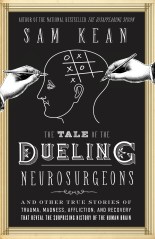
This post is in partnership with Publisher’s Lunch. To get a free copy of their new collection Buzz Book 2014, click here.
In 1559, the two surgeons Ambroise Paré and Andreas Vesalius discussed trepanning the skull of King Henri II of France to remove any excess fluids and “corrupted” blood inside, but the risks outweighed the benefits and they gave the idea up. In the meantime, they examined the heads of the decapitated criminals. History doesn’t record the exact methodology here—whether someone fixed each head inside a vice to provide a stable target, or perhaps strung the noggins up like piñatas to swing at—but the Count de Montgomery’s stump got quite a workout battering their mugs. It was a macabre mix of medieval brutality and modern experimental savvy, and Paré and Vesalius eagerly examined them for clues. Alas, they offered little inspiration for treatment.
(MORE: The Brain in 3D: New Model Details the Human Brain Down to its Cells)
Instead, the two men could have learned a lot more by simply observing the king, whose suffering foreshadowed many great discoveries over the next four centuries of neuroscience. Henri continued to drift in and out of coherence, limning the borders of the unconscious. He suffered from seizures and temporary paralysis, two then-mysterious afflictions. Strangely, the paralysis or seizures would derange only half of his body at any one time, a clear hint (in retrospect) that the brain controls the body’s halves independently. Henri’s vision also went in and out, a clue that the back of the brain (where Paré expected to find the contrecoup damage) controls our sense of sight. Worst of all, Henri’s headache kept widening, which told Paré that his brain was swelling and that blood vessels had ruptured inside the skull. As we know today, inflammation and fluid pressure can crush brain cells, destroying the switches and circuits that run the body and mind. This explains why brain injuries can be lethal even if the skull suffers no fracture. Skull fractures can in fact save people’s lives, by giving the swollen brain or pools of blood room to expand into. The history of neuroscience has proved the brain amazingly resilient, but one thing it cannot stand is pressure, and the secondary effects of trauma, like swelling, often prove more deadly than the initial blow.
King Henri II of France finally succumbed to an intracranial hemorrhage at 1 p.m. on July 10. Queen Catherine ordered every church to say six requiem masses daily, and ordered all church bells—which had been bleating for the king—silenced. Amidst this sudden, sinister quiet, Vesalius and Paré began their famous autopsy.
(MORE: The Brain: What The Mouse Brain Tells Us)

To cut open a king—to even suggest such a thing—was bold. In that era, anatomists might open someone up for one of two reasons, a public lecture or an autopsy. Both activities had a stink of the disreputable about them. By the mid-1500s, a few cities, especially in Italy, had relaxed the old prohibition on dissections for teaching purposes, but only barely: authorities might allow one per year (usually in winter, to prevent spoilage), and only then of criminals, since an official sentence of “death and dissection” would wring a little more posthumous punishment out of the rogue. Most kingdoms limited autopsies to suspected cases of poisoning, infanticide, or other heinous acts. And in some cases an “autopsy” did not require actually cutting open the body. Why Catherine gave in to Paré and Vesalius and permitted a full, invasive autopsy of Henri isn’t clear, since everyone knew who had killed him and how, but history remains grateful she did.
Vesalius had laid out the proper steps for opening the skull in Fabrica. This usually involved lopping the head off, to make examining the brain easier, but out of deference to the king, he merely elevated the chin in this case, by placing a wooden block beneath the royal nape. Someone grabbed a fistful of the king’s graying hair, to steady him, while someone else (presumably Vesalius, the expert dissector) began sawing the skull an inch above the eyebrows. After circling the head, he removed the skull vault, and encountered the thin membranes surrounding the brain (the meninges). In Fabrica Vesalius suggested that students nick the meninges with their thumbnails and unwrap them. He then encouraged students to plunge their fingers in and squeeze and fondle every fold: dissection was as much a tactile as a visual pleasure for him. But once again, Vesalius restrained himself with Henri—probably in part because Henri’s brain didn’t look all that appetizing. The front and sides looked normal, but in the rear—antipodal to the blow—Vesalius and Paré found pools of blackened fluids bulging beneath the meninges, like blisters about to burst. The brain itself had also yellowed and putrefied back there, a pus-y mass that measured one thumb’s-width across by two thumb’s-widths tall. Equally important, they found that the wooden shards from Montgomery’s lance had never penetrated the brain.
It’s not always clear what Vesalius and Paré understood, in modern terms, of how brain damage kills. In their reports they often lapsed into talk of imbalanced humours and “animal spirits” escaping Henri’s body. They knew nothing of neurons or localization. And the shards from Montgomery’s lance probably led to an infection that weakened Henri and hastened his death—a complication they couldn’t have grasped. But the duo understood well enough that the “commotion” and “corruption” in the back of Henri’s brain, along with the resultant pooling of blood, had ultimately killed him. Trauma to the brain alone, they determined, could be deadly, even without a skull fracture. And in proving this, they vastly outdid the mutterings of that old phony, Nostradamus. Nostradamus had equivocated about lions and cages of gold. Vesalius and Paré had predicted what sort of damage they’d find inside Henri’s brain and exactly where they’d find it—and find it they did. They proved science the superior clairvoyant.
Publishers Lunch’s just-released free ebook Buzz Books 2014: Spring/Summer includes a pre-publication excerpt from The Dueling Neurosurgeons—from which this selection is adapted—plus samples of dozens of other books that will published in the months ahead.
Buzz Books 2014: Spring/Summer by Publishers Lunch
The Tale of the Dueling Neurosurgeons. Copyright © 2014 by Sam Kean. Used by permission of Little, Brown, a division of Hachette Book Group.

